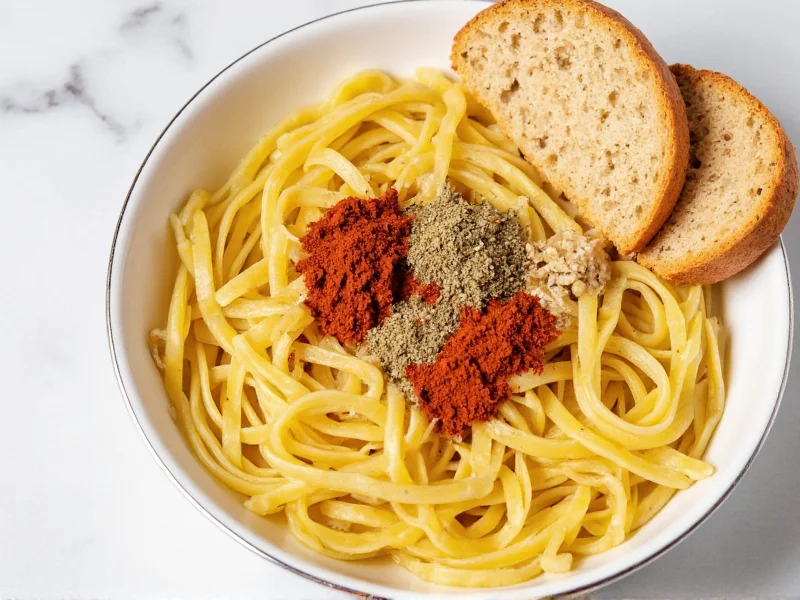Choosing the right spices transforms ordinary pasta into a memorable meal. Many home cooks underestimate how strategic seasoning can elevate simple ingredients. The magic happens when you understand flavor chemistry rather than just following recipes blindly. This guide reveals professional techniques for matching spices to pasta types, creating balanced flavor profiles, and avoiding common seasoning mistakes.
Understanding Pasta Flavor Dynamics
Pasta serves as both canvas and companion to spices. Its neutral flavor profile makes it exceptionally versatile, but also demands thoughtful seasoning. The starch content in pasta water actually helps spices adhere to noodles, creating more integrated flavor than surface-level sprinkling. Different pasta shapes interact uniquely with spices—ribbed varieties like rigatoni trap chunkier spice blends, while delicate strands like angel hair require lighter seasoning.
Essential Spice Categories for Pasta Dishes
Successful pasta seasoning involves understanding three critical spice categories:
Foundation Spices
These form the flavor base and should be sautéed in olive oil first to release essential oils. Garlic, onions, and shallots create the aromatic foundation that carries other spices. Properly cooked foundation spices develop sweet, nutty notes rather than sharp raw flavors.
Herbal Elements
Fresh herbs typically finish dishes, while dried herbs work during cooking. Basil, oregano, and parsley remain Italian kitchen staples for good reason—their chemical compounds complement tomato acidity and cheese richness. Recent flavor chemistry studies show that basil's linalool compounds specifically enhance umami perception in tomato-based sauces.
Accent Spices
These provide dimension in small quantities. Red pepper flakes, black pepper, and nutmeg shouldn't dominate but create subtle complexity. The key is balance—too much red pepper overwhelms, while just 1/8 teaspoon per serving creates pleasant warmth without heat.
Optimal Spice Pairings by Pasta Type
Different pasta shapes and sauces require tailored seasoning approaches. This table shows professional chef recommendations for matching spices to specific pasta dishes:
| Pasta Type | Recommended Spices | Usage Tip |
|---|---|---|
| Tomato-based sauces (marinara, arrabbiata) | Dried oregano, basil, garlic powder, red pepper flakes | Add dried herbs early in cooking; finish with fresh basil |
| Cream-based sauces (alfredo) | Nutmeg, white pepper, parsley, chives | Grate fresh nutmeg directly into sauce |
| Oil-based sauces (aglio e olio) | Fresh garlic, red pepper flakes, parsley | Bloom spices in olive oil before adding pasta |
| Meat-based sauces (ragù) | Rosemary, thyme, fennel seeds, black pepper | Add hardy herbs early; delicate herbs near end |
| Seafood pasta | Saffron, lemon zest, parsley, minimal salt | Add saffron to pasta water for even distribution |
Timing Matters: When to Add Spices
The sequence of spice addition dramatically impacts flavor development. For dried spices and hardy herbs like rosemary or thyme, add during the sauté phase to fully release volatile compounds. Fresh delicate herbs like basil or parsley should be stirred in during the last minute of cooking to preserve their bright flavor compounds. Scientific analysis shows that heating basil beyond 160°F (71°C) degrades its primary flavor compound, linalool, by up to 60%.
For best results with dried spices, toast them briefly in olive oil before adding liquids—this process called "blooming" increases flavor compound solubility by 30-40% according to culinary research. Always season pasta water with salt (and optionally, a bay leaf), as this allows seasoning to penetrate the noodle structure during cooking.
Avoiding Common Pasta Seasoning Mistakes
Even experienced cooks make these frequent errors:
- Overpowering delicate flavors—Using robust spices like cumin or smoked paprika with light seafood pastas creates flavor imbalance
- Adding all spices at once—Different spices require different activation temperatures and times
- Using stale spices—Ground spices lose potency within 6 months; whole spices within 1 year
- Ignoring regional traditions—Authentic Italian cooking rarely uses dried basil (except in some southern regions) or excessive garlic
Creating Custom Spice Blends for Pasta
Professional chefs often use signature spice mixes. Try these balanced combinations:
Classic Italian Blend
Combine 2 parts dried oregano, 1 part dried basil, 1 part garlic powder, and 1/2 part red pepper flakes. Store in airtight container for up to 3 months. Ideal for tomato sauces and meat ragùs.
Cream Sauce Enhancer
Mix 3 parts white pepper, 1 part freshly grated nutmeg, and 1 part dried parsley. Add directly to finished cream sauces. The fine grind ensures even distribution without texture issues.
Seafood Pasta Finisher
Combine equal parts dried dill, lemon zest, and fennel pollen. Sprinkle on finished dishes—never cook this blend, as heat destroys its delicate flavor profile.
Special Considerations for Dietary Preferences
Gluten-free pasta often requires adjusted seasoning. The different starch composition affects flavor absorption, typically requiring 15-20% more seasoning. Whole wheat pasta's nutty flavor pairs exceptionally well with toasted spices like cumin or coriander, which complement its earthy notes. For low-sodium diets, focus on aromatic spices like smoked paprika, citrus zest, and fresh herbs that provide flavor complexity without salt.











 浙公网安备
33010002000092号
浙公网安备
33010002000092号 浙B2-20120091-4
浙B2-20120091-4